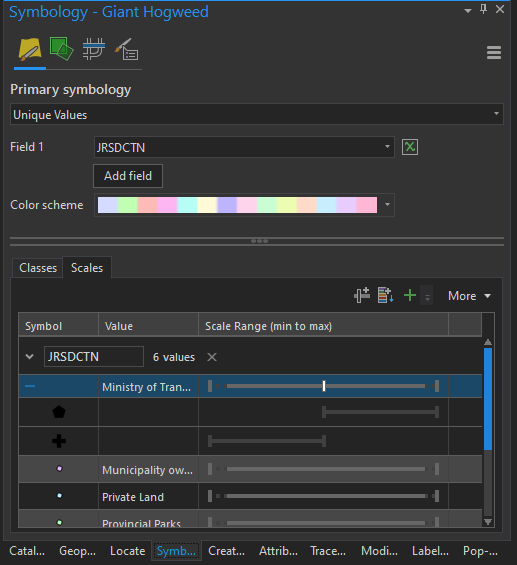- Home
- :
- All Communities
- :
- Developers
- :
- Native Maps SDKs
- :
- .NET Maps SDK Questions
- :
- Re: alternate symbol Runtime support
- Subscribe to RSS Feed
- Mark Topic as New
- Mark Topic as Read
- Float this Topic for Current User
- Bookmark
- Subscribe
- Mute
- Printer Friendly Page
alternate symbol Runtime support
- Mark as New
- Bookmark
- Subscribe
- Mute
- Subscribe to RSS Feed
- Permalink
- Report Inappropriate Content
In ArcGIS Pro, it is possible to add alternate symbols for a set of unique value-derived symbols to allow for different symbology for a given class at different scale ranges. I've attached a screenshot of what I mean.

This works great in ArcGIS Pro...I zoom in and out, and the symbol changes completely when going through the scale threshold.
However, when I export the map into a Mobile Map Package, the scale-changing behavior does not take effect. Instead, the point only shows when in the scale range for the first symbol in the list (i.e. the scale range starting at 0.0), and once I've zoomed through the threshold, the point disappears.
In other words, it appears that ArcGIS Runtime (tested against 100.7) does not support alternate symbols for scale ranges in this manner.
Questions are...
- Is this expected to work, or is this a bug/missing feature?
- If this is not expected to work, is this on the ArcGIS Runtime roadmap, and for which release?
- Mark as New
- Bookmark
- Subscribe
- Mute
- Subscribe to RSS Feed
- Permalink
- Report Inappropriate Content
You are right, Runtime SDK does not honor/support alternate symbols yet. This feature is currently not slated for any future release. Do you mind sharing your workflow and a use case explaining why do you need this feature and how will it help you in achieving your workflow? This info will help us in prioritizing and will give some more weight to its usability from a Runtime-SDK user perspective.
Thanks,
Preeti
- Mark as New
- Bookmark
- Subscribe
- Mute
- Subscribe to RSS Feed
- Permalink
- Report Inappropriate Content
We implement mobile software that utilizes the ArcGIS Runtime for utility companies. By and large, their existing maps all have at least some layers for which the symbol for the layer changes either completely or in size only based on scale ranges. Reference scales are not commonly used, and that is our client's preference. In order to replicate this functionality in the Runtime, the only available option is essentially creating the same layer multiple times, with each layer turning on/off in a defined scale range and having a somewhat different symbol. This makes it look like it's acting about the same as the symbol scale ranges referenced in the original question, but is orders of magnitude more difficult to maintain because any layer changes not having to do with symbols have to be replicated across all the layers used to mimic the symbol scale range functionality.